Arguably, the best-known configuration for early hinge-action British breech-loaders is the lever-over-guard, whereby the underlever to disengage the barrels is rear-facing and follows the contour of the trigger guard bow.
It is probably the first image that comes to mind when considering a pin-fire or early central-fire game gun, as this configuration was widely produced. While lever-over-guard guns are typically called Jones-type actions, not all are based on Henry Jones’s sturdy design.
Jones patented his double-bite screw grip action in 1859, and he famously let the patent lapse in late 1862, allowing anyone to copy it freely from that date onwards. But Jones was not the first to use the lever-over-guard, as single-bite actions with this feature pre-date the Jones patent, and these were not the first British guns with this type of under-lever configuration. That distinction goes to Charles Lancaster’s slide-and-tilt breech-loader, built for his proprietary base-fire cartridge and the Pottet/Schneider central-fire cartridge, starting in 1853, some six years before the Henry Jones design.
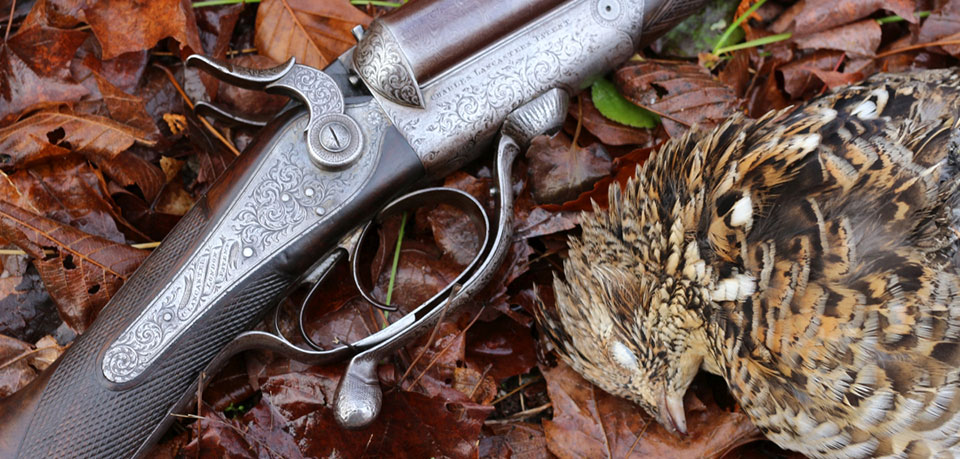
The Lancaster gun originated with Albert Henri Marie Renette of Paris, who obtained a French patent in 1835 for a slide-and-tilt capping-breech-loader. In 1853, Renette’s son-in-law and partner, Louis Julien Gastinne, received a French patent for this breech action on a hammer gun intended to use the then-new internally-primed Pottet/Schneider central-fire cartridges. The Gastinne design was patented in Great Britain in 1853, and the patent was assigned to Lancaster.
As with so many gunmaking innovations, the lever-over-guard configuration is French in origin. Furthermore, it may have been around since at least the early 1840s, if not before, a decade before the earliest British breech-loaders.
Beatus Beringer was a gunmaker and inventor of Paris and St. Étienne, and in 1832 and 1833, his first patents were for a breech-loading gun and pistol that used fulminate charges instead of gunpowder. He obtained 29 patents in the 1830s and 1840s, almost all dealing with breech-loading.
He invented his “Système Beringer,” which allowed his guns to fire pin-fire cartridges, or percussion caps and loose powder loaded into removable breech chambers. Contrary to the contemporary breech-loaders of the day equipped with forward-facing under-levers, his guns functioned with rearward-facing under-levers, whose shape also formed the trigger guard bow. His rearward under-lever may also have been built to align with a fixed trigger guard, as the lever-over-guard is still known in France as the Beringer lever.
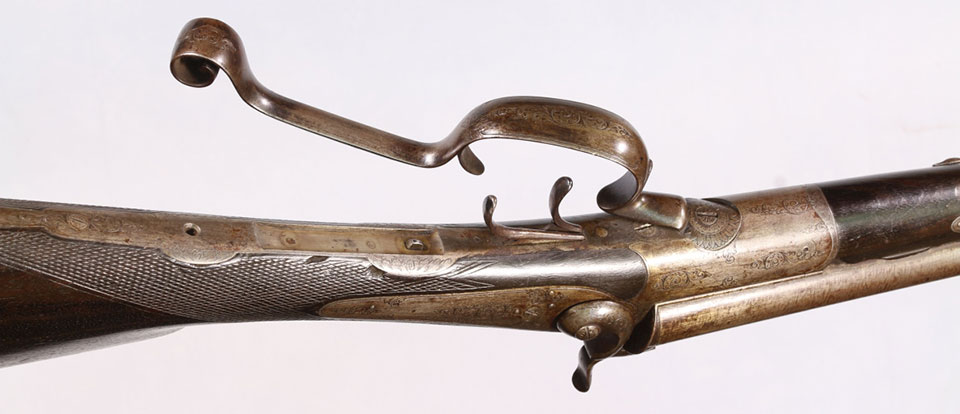
The earliest illustration I can trace of Beringer’s gun is in Edouard Foucaud’s Les Artisans Illustres [The Illustrious Artisans], published in Paris in 1841. The illustration depicts three important characteristics: the first is the combined under-lever-and-trigger guard, the second is a single-bite barrel lug attachment, and the third is a stud rising from the action bar to assist with the opening and closing of the barrels.
If the latter two characteristics seem familiar, it is because they appeared on the first breech-loader offered by the London gunmaker Joseph Lang around 1853. The popular story is that a young gunmaker, Edwin C. Hodges, was inspired by Casimir Lefaucheux’s pin-fire gun on display at the Great Exhibition of 1851, and he created his version, which he subsequently convinced Lang to build and market.
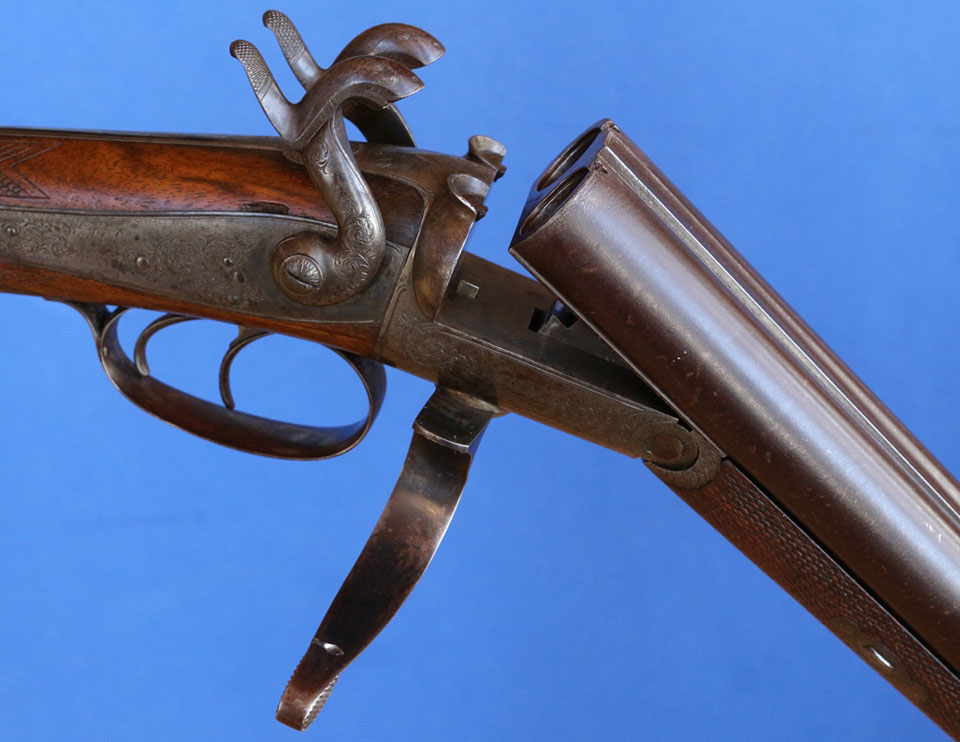
Lang’s design was copied by several of his contemporaries, notably John Blanch and Edward M. Reilly, and the slow march towards acceptance of the sporting breech-loader in Britain began. One aspect of this story has always bothered me: Lefaucheux’s gun, shown in the 5 July 1851 supplement of The Illustrated London News, depicts the double-bite barrel attachment typically found on Lefaucheux’s guns.
Instead, a single-bite bolting system was used by Lang, which I believe was copied from Beringer, albeit with a forward-facing underlever reminiscent of Lefaucheux’s design or that of another maker.
Casimir Lefaucheux was not the only French gunmaker displaying his works at the Crystal Palace. In describing the Lefaucheux gun, The Illustrated London News mentioned “Claudin and others also have specimens of guns upon the same principle,” in reference to Ferdinand Claudin of Paris, who presented “Guns and pistols of new construction.”
Other French makers who may have presented pin-fire guns, or other types of breech-loaders, at the Exhibition included Beringer, Adolphe Bertonnet, Louis-François Devisme, Francois Berger, Gilles Michel Louis LePage-Moutier, Louis-Julien Gastine-Renette, Charles Hippolyte Houllier, Jules Duclos, and several others.
Hodges and Lang had the chance to examine French guns of different makers
Unfortunately, no contemporary descriptions of the guns these makers displayed are available. Beringer presented “five fowling pieces,” for which the Royal Commission awarded an honourable mention.
By 1851, many, if not most, French gunmakers were building breech-loading guns based on the designs of Lefaucheux, Beringer, Pierre Antoine Loron of Versailles, and others, all based on metallic-base self-contained cartridges. It would be odd indeed if Beringer had not exhibited his proprietary breech-loader. However, the official catalogue of the Exhibition does not provide details, and The Illustrated London News chose only Lefaucheux’s gun for illustration.
That two of Beringer’s action design elements turned up in Lang’s gun is unlikely to be a coincidence. There is also the possibility that Hodges and Lang had the chance to examine French guns of different makers in the two years between the closure of the Exhibition and the building of their first breech-loaders, allowing them to see for themselves the various levers and bolting mechanisms.
Though foreign guns were rare in the shooting field, they were not unheard of, even if they were only kept as curiosities. Another clue to the origins of the lever-over-guard in Britain is that Beringer’s guns were known and studied by the London gunmaking community. John Blanch purchased a Beringer gun in 1855, no. 2359, for study, an odd purchase if only Casimir Lefaucheux’s guns were known.
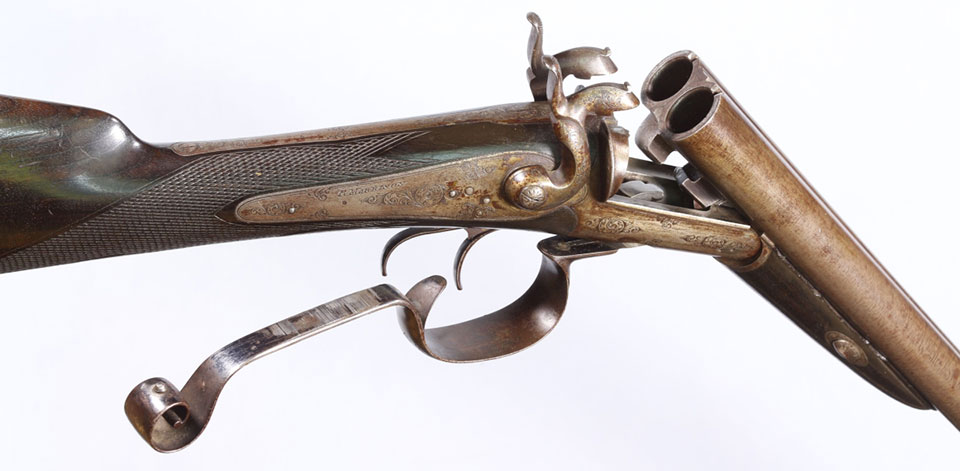
The term “Lefaucheux” was applied as a general description for a pin-fire breech-loader in period writings rather than specifying the maker. Unfortunately, this makes contemporary descriptions of pin-fire guns rather vague, as one cannot know if the reference is to guns by Casimir Lefaucheux or other makers. There is also no way of knowing the exact design of Blanch’s purchase, though surviving Beringer sporting guns are similar in form and design.
British pin-fire guns participating in the Field trials of 1858 and 1859 were of the Lang forward-underlever type. However, pin-fire guns from Reilly dating from 1858 and illustrations of Reilly guns around this time show a lever-over-guard configuration on what is otherwise Lang’s action design.
James Purdey famously built guns with the Beringer-type...
Guns with the combined underlever and trigger guard, but by other makers, did appear in both single-bite and Lefaucheux double-bite versions. James Purdey famously built guns with the Beringer-type combined underlever and trigger guard. Still, having never handled one of these Purdey guns, I cannot say if these were copies, actions made under licence, or actions purchased from Beringer or another maker. Robert Marrison of Norwich marketed a Belgian copy of the Beringer action, shown here, which, in outward appearance, looks like a typical Beringer gun with a short wooden fore-end and a rearward under-lever that doubles as the trigger guard.
The action, with twin locking lugs of the Lefaucheux pattern, was made by Jean Louis Mathieu Godin of Herstal, Belgium, and the barrels have both Liège and London proofs. The combined rearward under-lever and trigger guard bow is typical of Beringer’s design, locking in place with a stud on the rear end of the grip finial.
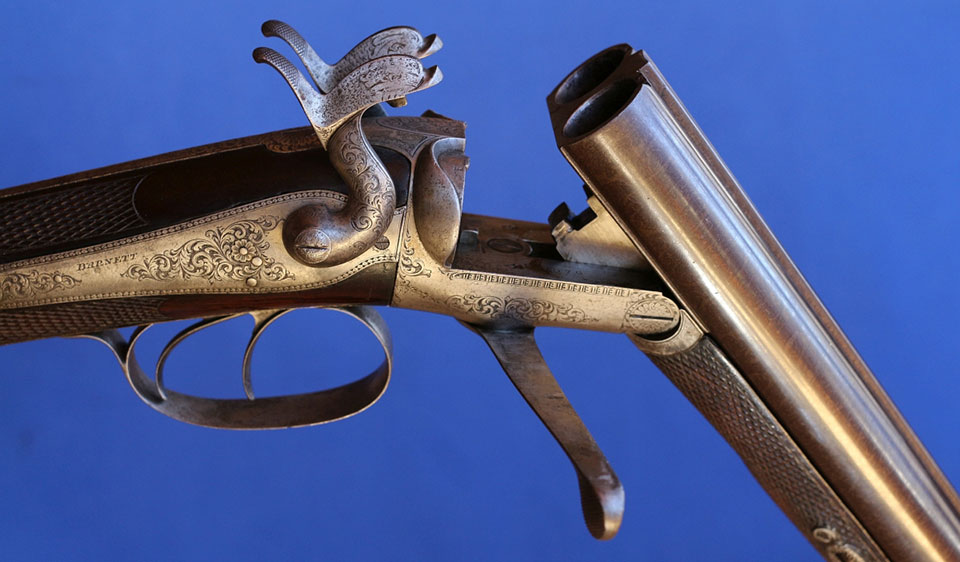
This gun has a grip-safety feature, where a small stud behind the triggers has to be depressed by the returned under-lever before the triggers can be pulled. I estimate the date of this gun to be around 1855 or soon after, as these guns had minimal appeal in Britain.
In summary, the lever-over-guard has French origins, and available information suggests Beatus Beringer may have been the first to reverse the under-lever on a breech-loading action.
The first British gun with the lever-over-guard was Lancaster’s, based on a French patent. Beringer further influenced early British breech-loaders, as Joseph Lang’s first pin-fire gun had more in common with Beringer’s designs than Lefaucheux’s.
The first British pin-fire guns with the lever-over-guard had single-bite actions, possibly influenced by Beringer, well before Henry Jones’s patent of 1859. Remember these facts the next time someone applies the generic “Jones under-lever” description to every hammer gun!
Stephen Nash
NOTES
Stephen Nash is a firearms researcher and writer living in Canada.
Published by Vintage Guns Ltd on (modified )




